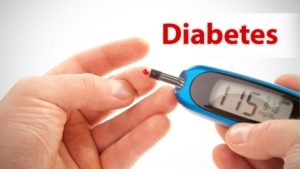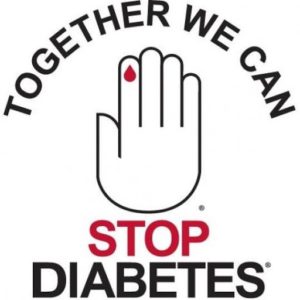Diabetes mellitus is a disease that affects the body’s ability to produce or use insulin. It can be defined as a chronic metabolic disorder that prevent the body to utilise glucose completely or partially.
Insulin is a hormone. When the body turns the food you eat into energy (also called sugar or glucose), insulin is released to help transport energy to the cells of the body. Insulin acts as a key. Its chemical message tells the cell to open and receive glucose. If you produce little or no insulin, or are insulin resistant, too much sugar remains in your blood. Blood glucose levels are higher than normal for individuals with diabetes. There are two main types of diabetes: Type 1 and Type 2.
When you are affected with Type 1 diabetes, your pancreas does not produce insulin. Type 1diabetes, once called juvenile diabetes, is often diagnosed in children or teens. However, it can also occur in adults. This type accounts for 5-10 percent of people with diabetes.Type 2 diabetes occurs when the body does not produce enough insulin, or when the cells are unable to use insulin properly, which is called insulin resistance.
The one of the most important risk factors for the development of type 2 diabetes is age over 45 years. Women are especially vulnerable in postmenopause, the final stage of menopause, due to serious hormonal changes. Type 2 diabetes is commonly called ‘adult-onset diabetes’ since it is diagnosed later in life, generally after the age of 45. It accounts for 90- 95 percent of people with diabetes. In recent years, Type 2 diabetes has been diagnosed in younger people, including children, more frequently than in the past. Type 2 diabetes mellitus is a chronic metabolic disease, affecting up to 6 percent of the worldwide population. There is an increase in blood glucose because tissues are unable to “grab” and utilize it. The main feature of this type of diabetes is the fact that the pancreas produces enough insulin, the hormone that makes body cells absorb glucose from blood, but the tissues do not respond to its signals.
Gestational diabetes usually goes away after pregnancy, but once you’ve had gestation diabetes, your chances are higher that it will happen in future pregnancies. In some women pregnancy uncovers Type 1 or Type 2 diabetes and these women will need to continue diabetes treatment after pregnancy. There seems to be a link between the tendency to have gestational diabetes and Type 2 diabetes later on.Before diabetes is diagnosed, there is a period where blood sugar levels are high but not high enough to be diagnosed as diabetes. This is known as prediabetes.
Another form is prediabetes. This condition causes a person’s blood sugar levels to be higher than normal but not high enough to be diagnosed with diabetes. The American Diabetes Association estimates that there are 84.1 million Americans that have pre-diabetes in addition to the 30.3 million with diabetes mellitus.
Genetics, lifestyle and environment can be the causes of diabetes. Eating an unhealthy diet, being overweight or obese and not exercising enough may play a role in developing diabetes, particularly Type 2 diabetes. Type 11 diabetes is caused by an autoimmune response. The body’s immune system attacks and destroys the insulin producing beta cells in the pancreas.
Over time, high blood sugar levels (also called hyperglycemia) can lead to kidney disease, heart disease and blindness. The excess sugar in the bloodstream can damage the tiny blood vessels in your eyes and kidneys, and can harden or narrow your arteries. The symptoms of diabetes mellitus include the following; extreme thirst, frequent urination, blurry vision, extreme hunger, increased tiredness, unusual weight loss.
If you are at risk for diabetes, you may be able to prevent or delay getting it. Most of the things that you need to do involve having a healthier lifestyle. So if you make these changes, you will get other health benefits as well. You may lower your risk of other diseases, and you will probably feel better and have more energy. The changes are
- Losing weight and keeping it off. Weight control is an important part of diabetes prevention. You may be able to prevent or delay diabetes by losing 5 to 10 percent of your current weight. For example, if you weigh 200 pounds, your goal would be to lose between 10 to 20 pounds. And once you lose the weight, it is important that you don’t gain it back.
- Following a healthy eating plan. It is important to reduce the amount of calories you eat and drink each day, so you can lose weight and keep it off. To do that, your diet should include smaller portions and less fat and sugar. You should also eat a variety of foods from each food group, including plenty of whole grains, fruits, and vegetables. It’s also a good idea to limit red meat, and avoid processed meats.
- Get regular exercise. Exercise has many health benefits, including helping you to lose weight and lower your blood sugar levels. These both lower your risk of type 2 diabetes. Try to get at least 30 minutes of physical activity 5 days a week. If you have not been active, talk with your health care professional to figure out which types of exercise are best for you. You can start slowly and work up to your goal.
- Don’t smoke. Smoking can contribute to insulin resistance, which can lead to type 2 diabetes. If you already smoke, try to quit.
- Talk to your health care provider to see whether there is anything else you can do to delay or to prevent type 2 diabetes. If you are at high risk, your provider may suggest that you take one of a few types of diabetes medicines.
Sometimes a routine exam by an eye doctor or foot doctor will reveal diabetes. Diabetes affects the circulation of your feet and the tiny blood vessels in your eyes. If your eye doctor or foot doctor suspects you have diabetes, they will recommend you to see your regular physician for a blood sugar level test.
The most common test is a fasting blood glucose test. After not eating for at least eight hours, usually overnight, your doctor will take a blood sample. The normal, non-diabetic range for fasting blood glucose is 70 to 110mg/dl. If your level is 126mg/dl or greater, you may have diabetes.
See your doctor so he or she can perform tests to determine whether or not you have diabetes or prediabetes. Your doctor will make recommendations to bring down your blood sugar level to treat diabetes or so that you can delay the development of Type 2 diabetes.
ARTICLE BY: JOYCELYNE YAYRA DELA- BOSO
CHRISTIAN SERVICE UNIVERSITY COLLEGE
DEPARTMENT OF NURSING.
LET’S STAND TOGETHER TO FIGHT AGAINST DIABETES





